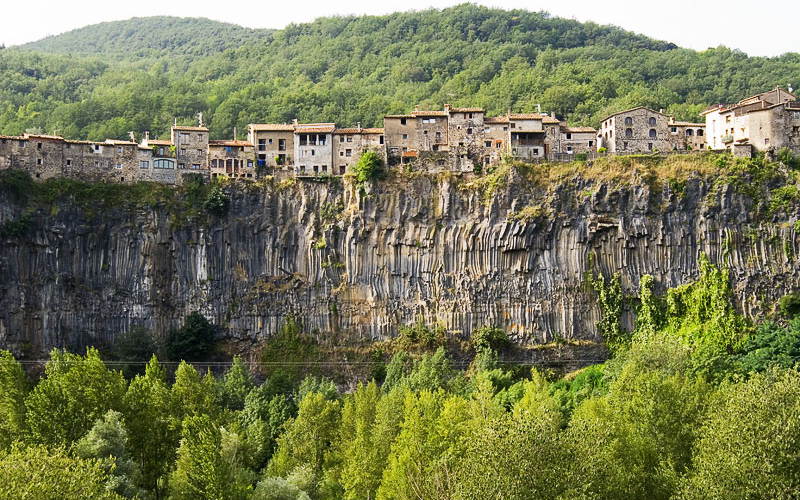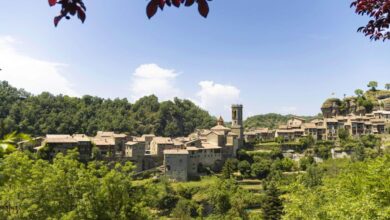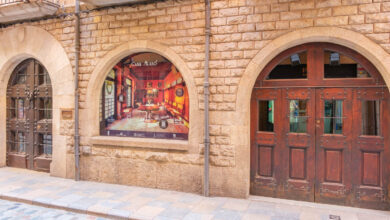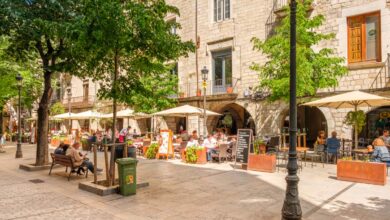
Castellfollit de la Roca, a village perched high
Castellfollit de la Roca is a village in the region of La Garrotxa, built atop a 50-meter-high basaltic cliff, extending for a kilometer in length, with the Fluvià River at its feet. The cliff is the result of the superposition of two lava flows that have undergone erosive action from the Fluvià and Toronell rivers over thousands of years.
Castellfollit is the smallest municipality in the province of Girona and the second smallest in Catalonia. The basalt quarry in the town is the only one of its kind still active in the whole of Spain. With its medieval origins, the village and its walls were destroyed during the earthquakes of 1427 and 1428. Its narrow and winding streets lead to one end of the cliff, where the church and the Josep Pla viewpoint are located, offering spectacular views of the landscape. This landscape, due to its volcanic nature, is diverse and lush.
Just before reaching the village, by the river, there is a parking lot from which you can contemplate the imposing basaltic wall and the houses that seem to literally hang from the precipice.
The Church of Sant Salvador, built in the 13th century and of Renaissance style, has undergone some renovations over the years. The current temple was reconstructed after the Spanish Civil War and still retains a Romanesque window.
Today, the building is not used as a place of worship but rather as a cultural center. Inside, temporary exhibitions can be seen, usually dedicated to painting, as well as the village’s giants and big-head figures. It’s worth climbing the four floors that lead to the tower, the old bell tower. From the top, where the bells used to be, one can contemplate the entire valley formed by the rivers and have an impressive view from the height where the village was constructed.
In Castellfollit, you can visit two museums. One of them is the Embutit Museum. It features a permanent exhibition based on the history of meat preservation. Different tools and machines used for meat processing over the years can be seen, along with old photographs and videos that recall traditional home slaughtering. Tastings of typical regional products are also offered.
The other museum is the Vietnam Museum, dedicated to the wartime conflict that took place during the 1960s and 1970s of the 20th century. The driving force behind this project is Martí De Miquels, a passionate and worldwide reference on this subject, who has managed to create one of the most comprehensive collections in the world about the Vietnam War, and the only one in Europe. The museum displays all sorts of objects: weapons, uniforms, photographs, conflict posters, medical supplies, personal documents, even a small fragment of a North American aircraft’s fuselage.
In addition to the museums, Castellfollit holds an annual lead figure exhibition-contest. Here, you can see miniature metal figures that do not exceed one hundred and twenty millimeters in height, and they are truly works of art.
Castellfollit de la Roca is situated within the Natural Park of the Garrotxa Volcanic Zone and serves as one of its gateways. The Park, comprised of around forty volcanic cones, over twenty lava flows, and eleven municipalities, is one of the finest examples of volcanic landscapes in Spain. Various routes traverse the woods and lava flows. One of these leads to Castellfollit and is part of the ancient Annia route, a path the Romans used to transport minerals extracted from the Pyrenees mines to the port of Emporion.
The landscape in this part of the Garrotxa region is gentle and with few gradients, characterized by valleys and forests. The area, one of the most wooded in Catalonia, is well-known for its beech, oak, and pine forests. The twenty-eight itineraries that crisscross it, most of them signposted, are connected to the Itinnerària network of paths, which allow you to reach any point in the regions of Garrotxa, Ripollès, or Alt Empordà on foot.
All of this invites various outdoor activities: hiking, cycling, horseback riding, hot air balloon trips, or adventure sports. This is why Castellfollit de la Roca and its surroundings are an ideal destination for nature and sports tourism enthusiasts.




